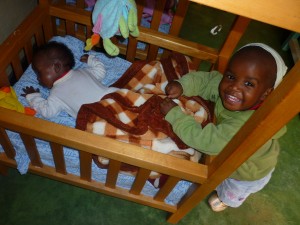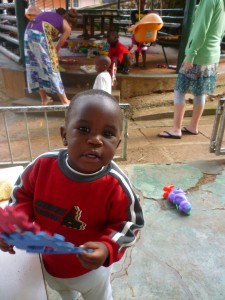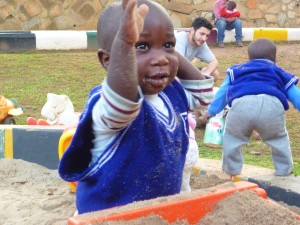By Reta Raymond
Associate Special Features Editor
There are nearly two million known orphans in Uganda. Many of these orphans lost their parents to AIDS, or the children were not kept because they were born out of wedlock, or their parents were simply too poor to keep them. Additionally, women who give birth in Uganda have a high mortality rate. This high mortality rate is in part due to the requirement that women in labor must bring their own medical supplies needed for labor, or they will be turned away from hospitals and clinics. Often that will lead to women giving birth outside a medical facility in unsanitary conditions.

While in Kampala, I stayed at Sanyu Babies Home, which is the oldest babies home in Kampala. It runs on private donations and income-generating projects such as the on-campus guesthouse and craft shop. There is no government funding for orphanages in Uganda. Sanyu houses around fifty children, whose ages range from one day to four-years-old. This home has an excellent track record of getting children adopted, fostered, or reunited with their birth families. These children are often found in pit latrines, maternity wards, churches, near wells and on the side of the street. Some of the caretakers believe that some children are delivered to Sanyu to save the child from being sacrificed as part of a traditional “witchcraft” ceremony. They believe that certain beads worn around the children’s stomachs is evidence that a child has been chosen for sacrifice.

Children are generally very well taken care of at Sanyu. There, children are given three meals and two snacks per day. When the children come to Sanyu they are tested for AIDS, receive vaccinations, and are given medical treatment by the resident nurses or taken to a hospital if they require additional care. Many of the children are malnourished, have experienced trauma, or have other health problems when they are brought to Sanyu. These children, live in the equivalent of a middle-class Ugandan home.
However, Sanyu still struggles to provide medical care to the children, because it is difficult to pay their medical bills. When medical bills reach a certain level, the hospital will refuse to care for any more children. This past spring, one of the volunteer caretakers from outside Africa carried pneumonia to the home and infected many of the children. As a result of this outbreak, three children died and many were put in the hospital, which left Sanyu with some debilitating bills. Not only must Sanyu pay for the medical services when a child falls ill, but also for the medical supplies. For example, if a child needs stitches, Sanyu must bring the scissors, gauze, and thread. Therefore, the medical bills can escalate rapidly, and if they do not pay the bill for a long time, the hospital will simply refuse to treat any more of Sanyu’s children. After the pneumonia outbreak, Sanyu worried that they wouldn’t be able to pay the bill before another child would need to visit the hospital.
Sanyu is also unique because it is a somewhat transparent organization. Donors may pay hospitals, electricity bills, and vaccinations directly on behalf of Sanyu. An administrator, whose decisions are subject to a board of director’s approval, runs the home. However, recent criticisms of their financial decisions make me believe that Sanyu may not be free from corruption, which is widespread in Uganda.
Regardless, Sanyu is one of the best places for an orphaned child in Uganda to end up. Many international families, as well as local families, come to Sanyu to be matched with their potential child, and many international and local volunteers come to help care for the children. Many orphanages in Uganda are not nearly so lucky. For example, I visited another orphanage in Kampala where children were not fed one day per week, as a way of budgeting for food. At that orphanage, donations from international visitors were rare, as it is further out of the city and not well known. That orphanage housed over seventy children, with all the boys living in a two-room house without electricity. Furthermore, the children had to sleep two or three to a mattress.

—
For more information on how to help Sanyu, either by donating items or money or becoming a volunteer visit: http://www.sanyubabies.com.
Additionally, a $7 donation to “Mercy for Mamas” will buy a “mama’s kit” which provides an expectant mother with all the medical supplies she will need at the hospital to deliver her baby safely and in sanitary conditions. Since Ugandan medical facilities do not provide medical supplies to treat their patients, hospitals and clinics turn women away if they do not bring the proper medical supplies necessary to deliver the baby. For more information, visit: http://www.mercyformamas.com.
Another source of information is the child advocacy blog, “A Child’s Voice.” This blog posts on a variety of issues affecting children in Uganda, read more at http://a-childs-voice.org/.